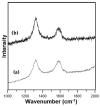Synthesis and Properties of Carbon Nanotube-Grafted Silica Nanoarchitecture-Reinforced Poly(Lactic Acid)
- PMID: 28773187
- PMCID: PMC5551872
- DOI: 10.3390/ma10070829
Synthesis and Properties of Carbon Nanotube-Grafted Silica Nanoarchitecture-Reinforced Poly(Lactic Acid)
Abstract
A novel nanoarchitecture-reinforced poly(lactic acid) (PLA) nanocomposite was prepared using multi-walled carbon nanotube (MWCNT)-grafted silica nanohybrids as reinforcements. MWCNT-grafted silica nanohybrids were synthesized by the generation of silica nanoparticles on the MWCNT surface through the sol-gel technique. This synthetic method involves organo-modified MWCNTs that are dispersed in tetrahydrofuran, which incorporates tetraethoxysilane that undergoes an ultrasonic sol-gel process. Gelation yielded highly dispersed silica on the organo-modified MWCNTs. The structure and properties of the nanohybrids were established using 29Si nuclear magnetic resonance, Raman spectroscopy, wide-angle X-ray diffraction, thermogravimetric analysis, and transmission electron microscopy. The resulting MWCNT nanoarchitectures were covalently assembled into silica nanoparticles, which exhibited specific and controllable morphologies and were used to reinforce biodegradable PLA. The tensile strength and the heat deflection temperature (HDT) of the PLA/MWCNT-grafted silica nanocomposites increased when the MWCNT-grafted silica was applied to the PLA matrix; by contrast, the surface resistivity of the PLA/MWCNT-grafted silica nanocomposites appeared to decline as the amount of MWCNT-grafted silica in the PLA matrix increased. Overall, the reinforcement of PLA using MWCNT-grafted silica nanoarchitectures was efficient and improved its mechanical properties, heat resistance, and electrical resistivity.
Keywords: multi-walled carbon nanotube; nanoarchitecture; nanocomposite; nanohybrid; poly(lactic acid) (PLA); silica.
Conflict of interest statement
The authors declare no conflict of interest.
Figures










References
-
- Kaushik B.K., Majumder M.K. Carbon Nanotube Based VLSI Interconnects Analysis and Design. Springer Inc.; New York, NY, USA: 2015. pp. 18–25.
-
- Majumder M.K., Kaushik B.K., Manhas S.K. Performance comparison between single wall carbon nanotube bundle and multiwall carbon nanotube for global interconnects; Proceedings of the IEEE international conference on networks and computer communications (ETNCC 2011); Udaipur, Rajasthan, India. 22–24 April 2011; pp. 104–109.
-
- Loos M. Carbon Nanotube Reinforced Composites. Elsevier Inc.; Boston, MA, USA: 2015. pp. 73–101. Chapter 3.
-
- Mintmire J.W., White C.T. Electronic and structural properties of carbon nanotubes. Carbon. 1995;33:893–902. doi: 10.1016/0008-6223(95)00018-9. - DOI
LinkOut - more resources
Full Text Sources
Other Literature Sources

